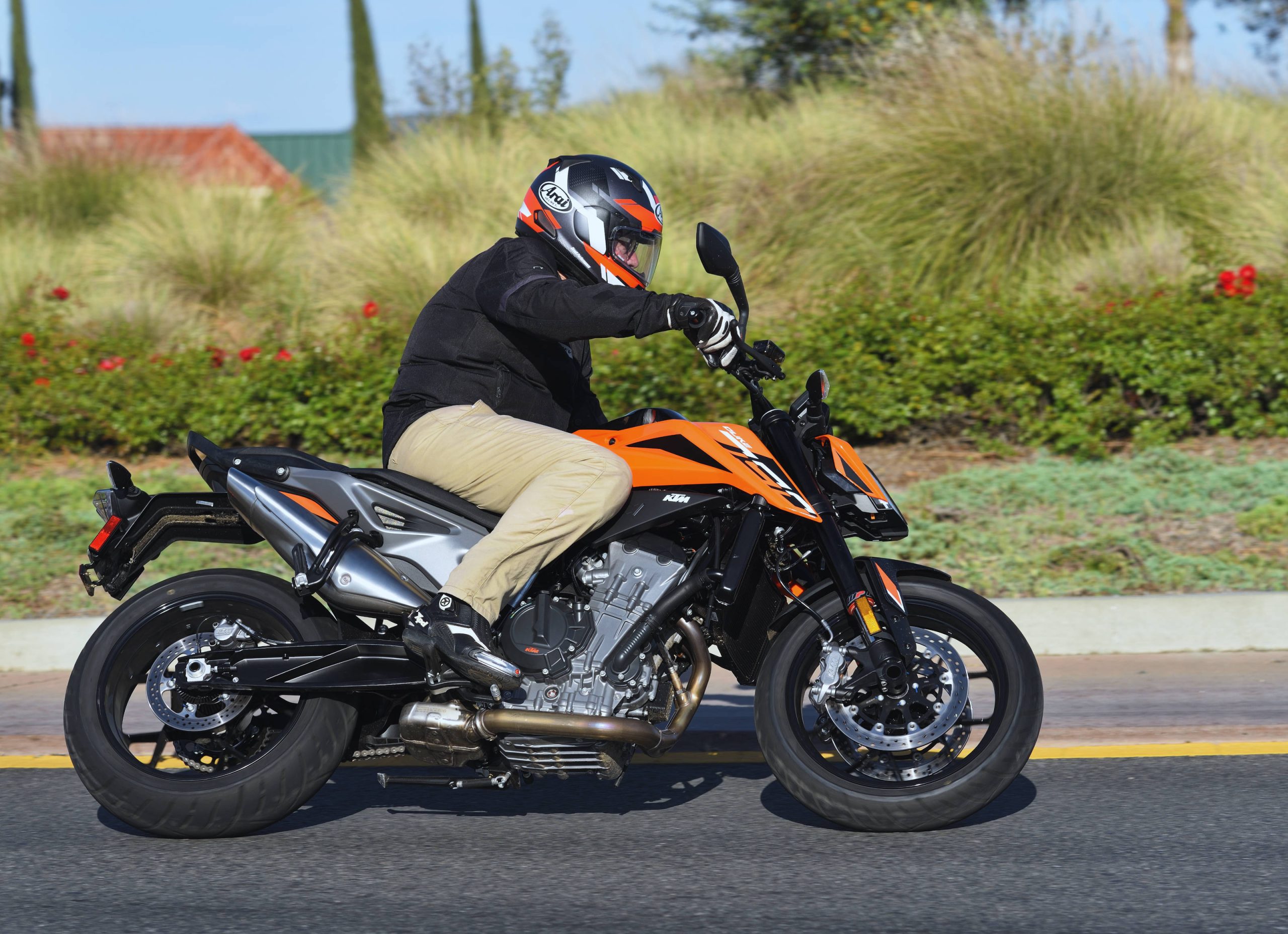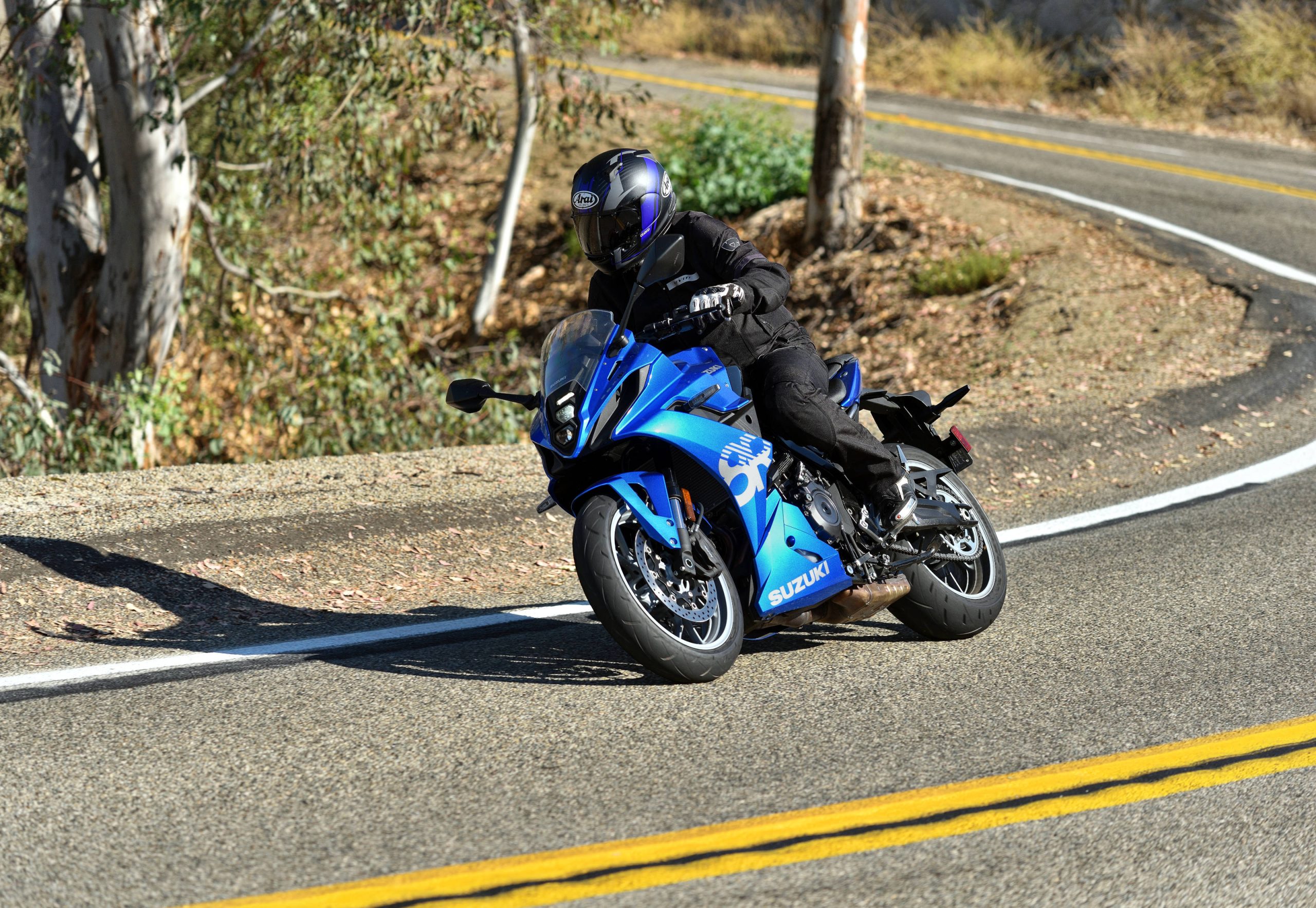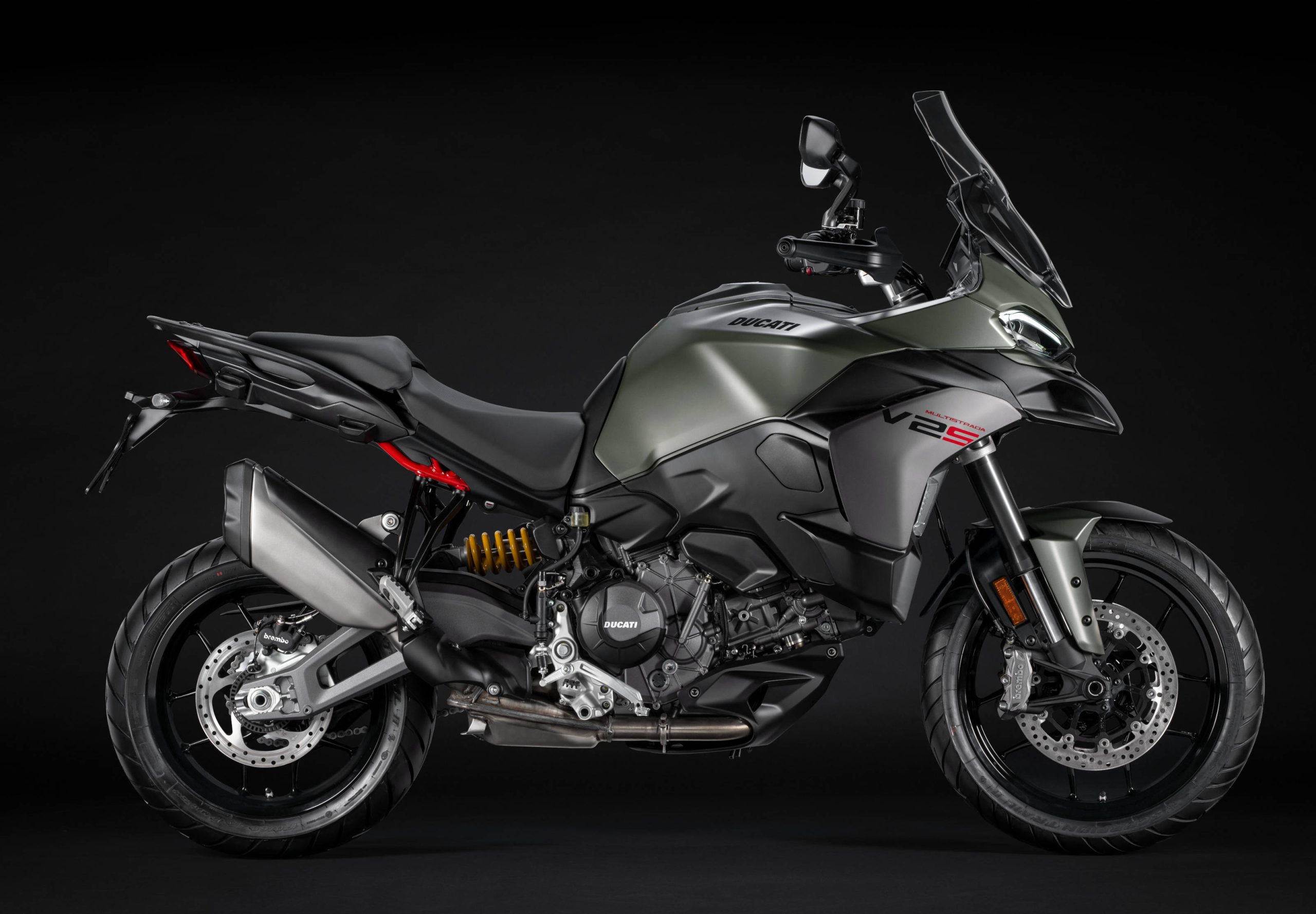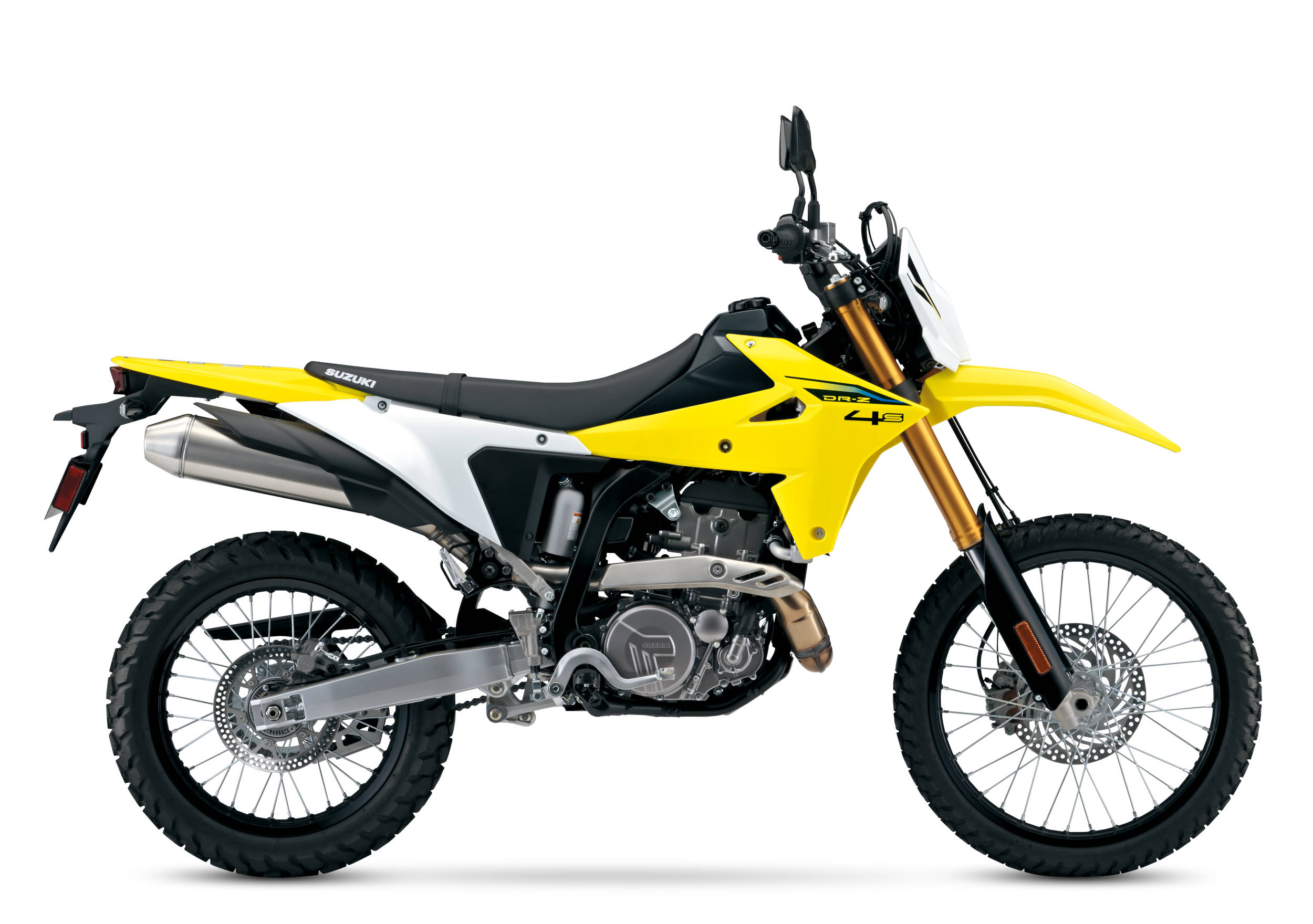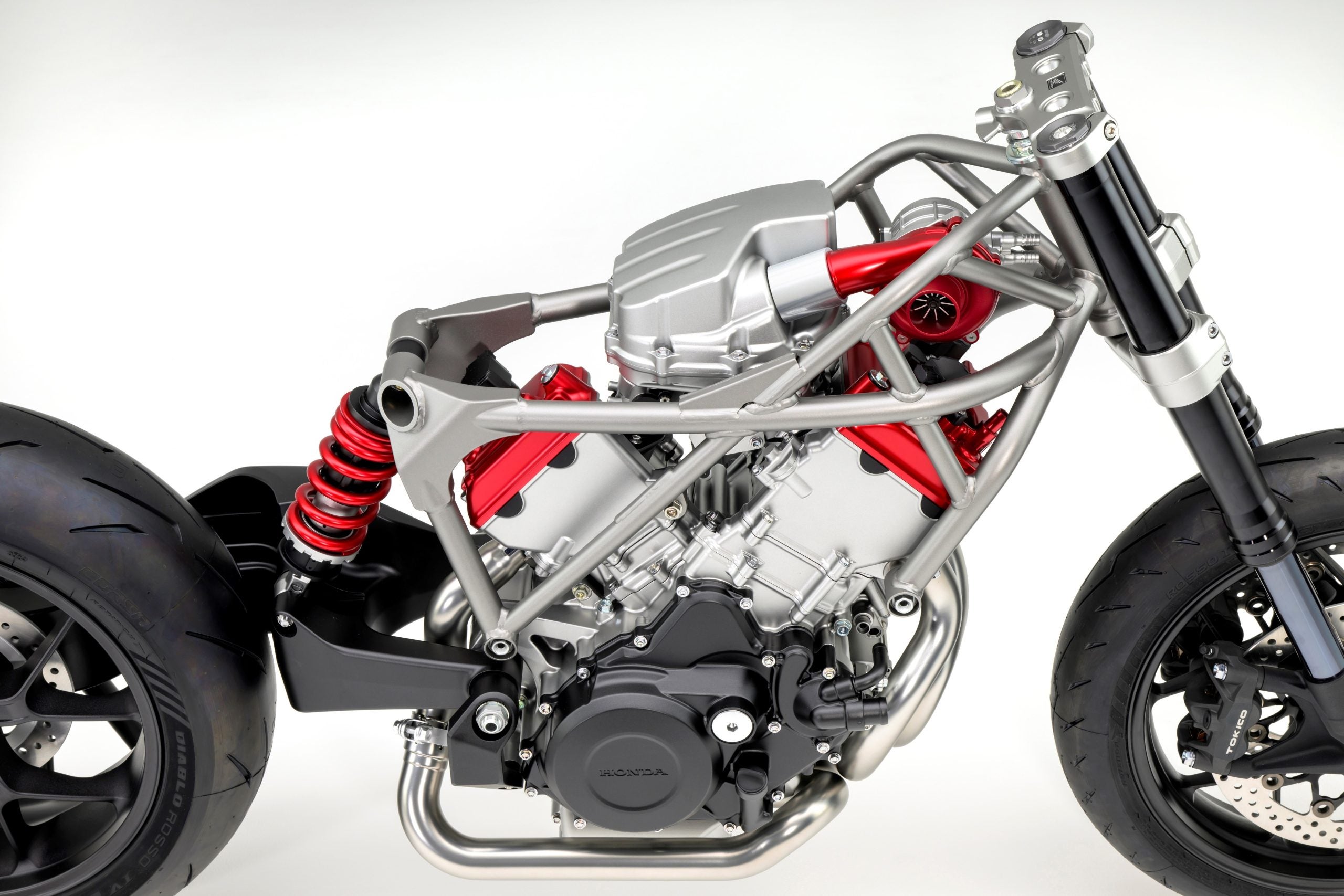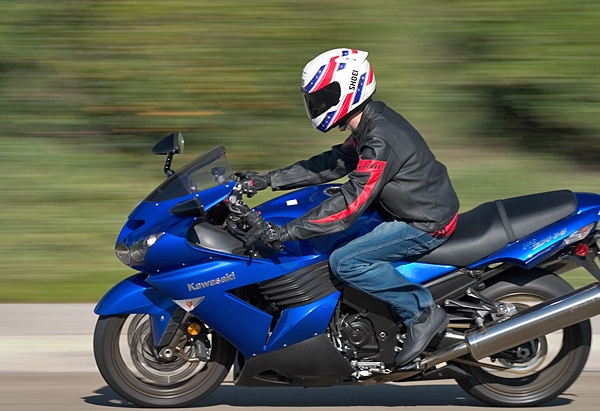
If you read our two-part ‘First Ride’ write-up on the ZX-14 back in March (Part One and Part Two), you know quite a bit about the performance of the ZX-14 – its acceleration, braking and handling. After Kawasaki’s press intro, we felt that we had a pretty good grasp of these factors, but we had a different goal in mind when we picked up a ZX-14 test unit from Kawasaki early last month – to find out what it’s like to spend some time actually living with the quickest and most powerful production motorcycle in the world.
Looking at Kawasaki’s claim of 190 horsepower (200 with ram-air) might give you the impression that the ZX-14 is a raw, untamed animal, and that everyday street riding would find it tearing at its leash, struggling to break loose and annihilate your license. However, nothing could be further from the truth – in day-to-day use, the beast is surprisingly docile. Leaving aside the brutal acceleration it is capable of, and its massive horsepower figure, the ZX-14 has many traits that make it a spectacular daily rider.
The ergonomics of the bike are nearly perfect, at least for this rider (5’9″, 135lbs). The seat is just the right width (wide, but not too wide), and extremely comfortable – so far, I’ve put over 2000 miles on our test bike, including several 200+ mile days, without ever experiencing any significant seat discomfort! The riding position isn’t quite as bolt upright as most tourers and standards, instead putting the rider into a slight forward lean – nowhere near as severe as most sportbikes, though. Although it does put a small amount of weight on your wrists (this might be worse if you carry more weight in your upper body than I do), for freeway riding I actually like this riding position better than most tourers. Once you get up to 70 or 80 mph, there is just enough wind hitting your chest to take the load off your wrists, but that slight forward lean actually puts less weight on your backside, and particularly your tailbone (which is where I usually ache after a long day of riding). Just a few days ago, I spent about 6 hours in the saddle in one day (riding two-up), and although my lower back was aching slightly at the end of the day (I have frequent back pain, stemming from some vertebral fractures I sustained in a MX accident a few years ago), there wasn’t the slightest hint of ‘monkey-butt’.
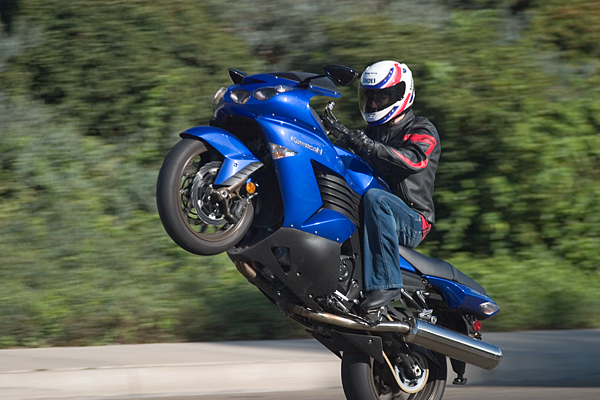
Wind protection is excellent as well … so good that it can get you in trouble! The mildness of the wind, combined with the ZX-14’s easy lope on the freeway, means that 110mph doesn’t feel much different than from 80mph, and more than once I caught myself running in the triple digits without even realizing it. Not only does the fairing provide excellent wind protection for your upper body, it keeps the majority of your legs and feet protected, as well. While the 14 does dump some of the hot air from the radiator onto your lower legs, it’s not nearly as much as a few sportbikes I’ve ridden lately, and is entirely bearable, even on hot Southern California days.
A big plus for those who plan to use their ZX-14 for touring is the digital gauge cluster, which provides the rider with a wealth of data. In fact, I feel compelled to warn readers not to get distracted by playing with it while riding. In addition to dual trip meters, there are displays of both instant and average MPG, range (the most useful of the bunch!), and even battery voltage, which will really come into its own for those riders who like to add electrical accessories. The average MPG gauge, however, is mildly optimistic, at least according to our calculations – on one 147 mile trip, which consisted of a mix of freeway and back road riding, for instance, the dash reported 36.4mpg, while we calculated 34.5. Still, it’s close enough to be informative (we recorded roughly 5% error), and it’s entertaining to see how your riding style affects the bike’s mileage figures.
Although the ZX-14 is a big bike – long and heavy (Kawasaki claims a dry weight of 474lbs, which means the bike is well over 500lbs wet) for a sport machine – it certainly doesn’t feel big when you’re riding it. Credit for this may go to Kawasaki’s design team and their work on mass centralization, but whatever the reason, this bike seems to shrink under you as soon as you get up to speed. At parking lot pace, tight maneuvering can require some manhandling, and you definitely notice the long wheelbase and heft. However, on the street, the highway, or even in the canyons, the ZX-14 handles amazingly well for a bike of its size. Evidence can be found in the accompanying photos, for at first I was doubtful that I would be able to corner hard enough on the ZX-14 to drag my knee. But aside from the suspension being slightly too soft when taking the full weight of the bike under hard cornering, the big blue Kawasaki was quite confidence-inspiring at big lean angles.
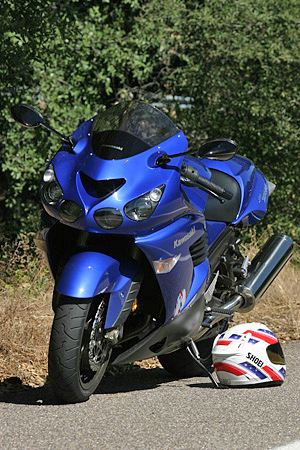
By the time you touch down the peg feelers, you’ve achieved enough cornering speed to satisfy almost any rider, but I felt confident that I could have dragged the wide fairings if I had carried a bit more speed (and removed the peg feelers, of course).
Despite its ability to achieve big lean angles, it is at a more relaxed cornering pace where this bike’s natural abilities truly shine. If you really want to enjoy the ZX-14, pick a two-lane highway with plenty of medium to fast sweepers. Likely due to the long wheelbase, the 14 is extremely stable in long, sweeping turns, holding exactly to the rider’s chosen line without the weaving or nervousness often encountered on sportbikes with shorter wheelbases and more aggressive steering geometry. Oddly enough, however, no undue effort is required to initiate a turn, and while I wouldn’t call the 14 an apex hunter or use the word ‘dive’ when describing its turn-in, it is impressively agile for such a large motorcycle. The only time the bike’s size and weight is truly noticeable is in fast side-to-side transitions, as when a left-hand corner closely follows a right (or vice-versa). Throwing the ZX-14 from side-to-side requires the exercise of some upper body strength, and while those riders (like myself) who are lacking in that department won’t find it too difficult at first, by the end of the day it can become somewhat fatiguing.
In slow, tight corners, the ZX-14 has a tendency to run wide at the exit. A little muscle power can hold it on the line, but as with transitions, this can quickly become tiring. However, unless you ride canyons with lots of tight 1st-gear corners, this is a problem that rarely presents itself.
Earlier I mentioned that the suspension can feel too soft when really pushing the bike at extreme lean angles (something most purchasers of the Zx-14 will rarely, if ever, do). However, that same suspension soaks up bumps, grooves, and freeway expansion joints with remarkable aplomb, transmitting plenty of feel to keep the rider informed, but isolating him from sharp impacts and harsh poundings. The ZX-14’s weight is certainly an aid to its ride quality, but the excellence of the suspension can’t be ignored.
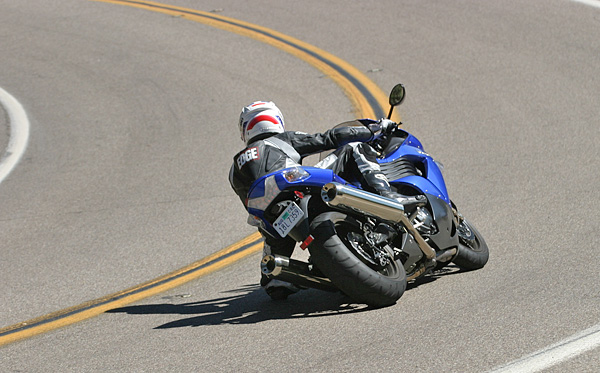
For those of you who frequently travel with a passenger on board, the ZX-14 provides very comfortable accommodations – in fact, the passenger seat is nearly as comfortable as the superb rider’s perch. The bike also handles well two-up, resisting the ‘chopper-like’ feel that often arises on smaller sportbikes when burdened with a passenger. This is true even when, as is often the case, the rider doesn’t get a chance to dial in additional preload before the passenger hops on board. Of course, most of the passengers I carried were light (between 100 and 140lbs), so your mileage may vary.
Around town, the ZX-14 continues to mask its size well, and makes an excellent day-to-day tool. The stability that comes from having less aggressive steering geometry than a 600cc or 1000cc sportbike makes it much more relaxing to ride at a slower pace, eliminating the need to constantly monitor the front end. Basically, riding around town on the 14 feels much like any comfortable mid-size sport-tourer – that is, until the light turns green and you unleash that monster motor.
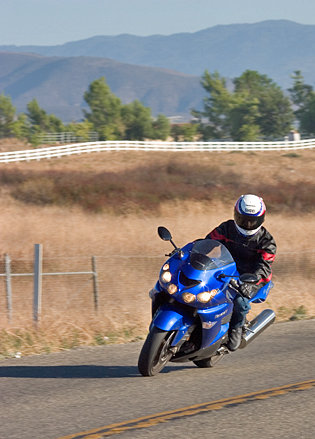
Ahh, with all this talk about handling, you thought I forgot about the motor? Trust me, the ZX-14’s 1352cc inline-four isn’t the kind of motor you forget about – care and respect of the throttle are always in your mind, even when riding slowly.
Although the ZX-14 doesn’t feel dramatically more powerful than some of the fastest liter bikes I have ridden (all that weight counteracts some of the extra power), it delivers its nearly 200 crank horsepower quite differently than any 1000cc sportbike. Whereas a ZX-10R’s acceleration can be neck-snappingly brutal, like the abrupt increase in velocity of a bullet as gunpowder explodes behind it in a confined space, the ZX-14’s speed is gained with smooth, constantly increasing drive – reminding me of the multi-stage booster rockets strapped to the bottom of the space shuttle. Once you ride one, you’ll understand the comparison.
Unfortunately, the motor has one flaw – soft power delivery below 4,000rpm. Above 4,000rpm things start to pick up, but it isn’t until 6,000rpm that they really get moving. After this, the bike charges forward with such seamless, relentless urge that, as I said above, a rocket is really the only comparison that does it justice. Just be careful to practice self-restraint, as this power can drive you into license-losing territory with terrifying rapidity. It will pass 100mph so quickly that it takes a sharp, clear-thinking rider to stay mentally ahead of the bike.
Aside from the low-end power delivery, there’s not much to complain about with this motor. Despite being rigidly mounted and used as a stressed member of the monocoque backbone frame, the twin-counterbalanced inline-four purrs along smoothly and sweetly at any speed, regardless of gear. In fact, not once during said two thousand miles aboard the ZX-14 have I noticed ANY significant vibration, anywhere. A side benefit of this is that the 14’s trick-looking, aerodynamically-molded mirrors are the most useful I’ve ever encountered – at 80mph on the freeway, you can read the numbers off the front plate of a car twenty feet back in the lane next to you! Assuming you can read backwards, that is.
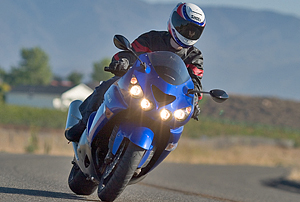
When it comes time to haul the bike back down from the ridiculous velocities it is capable of, the rider will find a willing companion in the powerful braking system. The twin floating four-piston calipers squeeze Kawasaki’s signature petal-shaped discs with serious authority, and excellent feel is transmitted to the rider via the brake lever. The brakes are progressive yet powerful, and inspire confidence even on such a powerful machine. The rear brake is equally progressive, and the ZX-14’s weight distribution actually allows the rider to use the rear brake fairly heavily without locking the rear wheel – the bike is fairly heavy and has a low center of gravity, so weight transfer off the rear wheel and onto the front under braking is not as severe as on a taller, lighter bike.
Before I wrap up this review, I need to make one comment on the ZX-14’s controversial styling. When Dirck and I first tested the bike at Kawasaki’s press introduction, I thought it was quite unattractive. Since then, the 14’s looks have grown on me, and while I don’t think it’s a pretty bike, it definitely has an aggressive, purposeful look, which is appropriate for such a powerful machine. I also want to mention that, while riding the 14 around for several months, I’ve found reactions to the bike’s looks by the general (non-motorcycling) public to be nothing short of amazing. Nearly everyone who sees it makes a comment to the effect of “it looks tough”, “that thing is sweet”, or my favorite, “that bike looks bad-ass!”. That last one, I think, is an appropriate description.
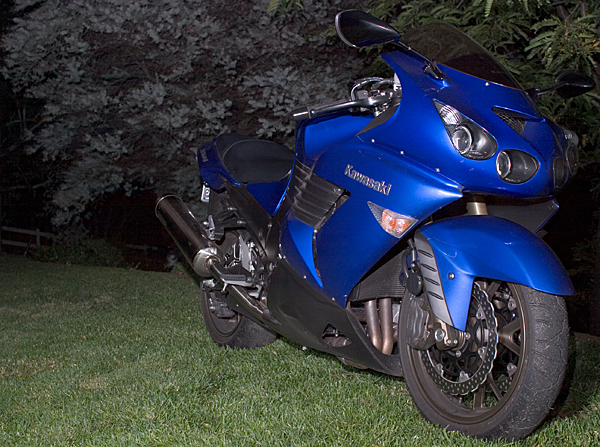
The bottom line is that I like the ZX-14. It’s an excellent all-around bike, comfortable enough to take a long, relaxed ride on the highway, fast enough to smoke down the drag strip in the rarified realm of single-digit quarter-mile times, and quick-handling enough to put a smile on your face in a canyon. In fact, I liked the bike so much that I convinced the good folks over at Kawasaki to let me hang on to it for a while. So keep your eyes on Motorcycle Daily, and I’ll keep you up to date as I make a few changes to the ZX-14. An exhaust system and Dynojet Power Commander should help eliminate, or at least reduce, the soft power delivery down low, and other modifications will be aimed at improving the bike’s drag strip prowess, touring ability, and even its looks. Stay tuned.

